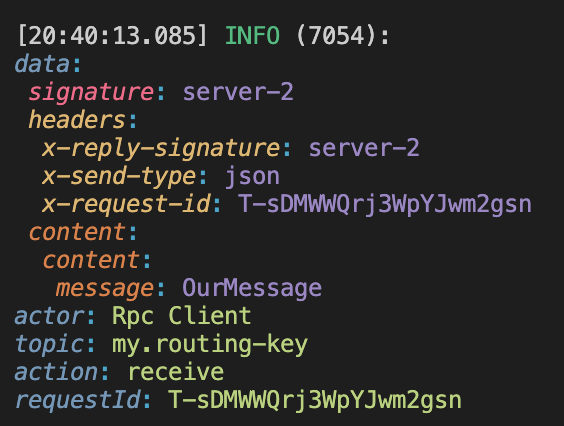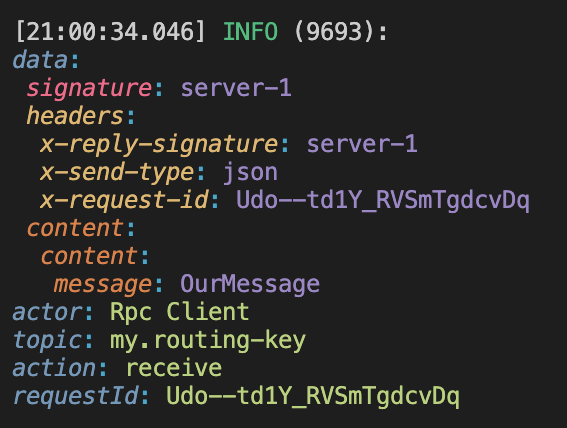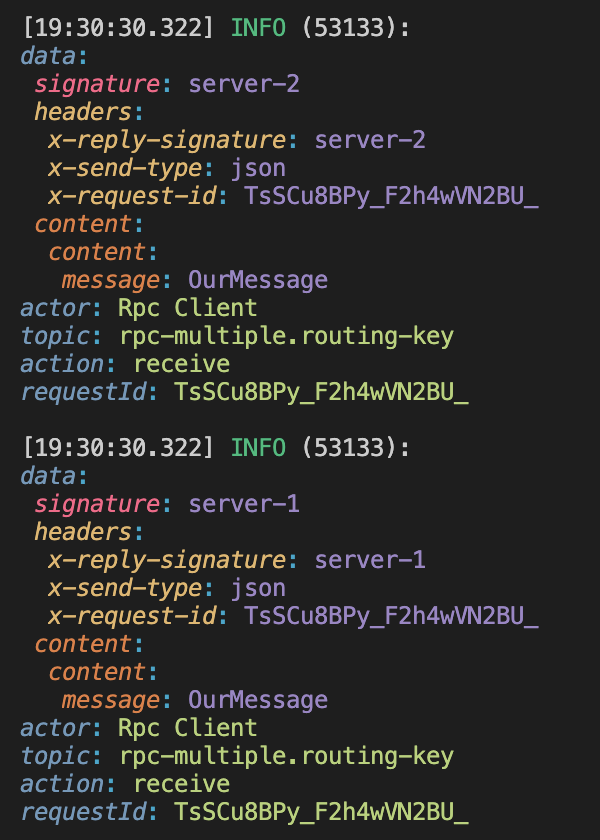Multiple RPC Communication
RabbitMQ out of the box gives us 2 possible communication patterns, server-client and the rpc.
However, it gives us enough tools to build our own patterns
The biggest feature of r4bbit is actually providing a design pattern that is not implemented by RabbitMQ. Multiple rpc communication.
In this pattern, basically, a client publishes an rpc message to an exchange with a topic name. Then receives multiple replies from different servers.
There are two possible strategies of receiving multiple replies from rpc servers.
- If we know how many replies we will receive, then we wait until receiving all the replies and take an action afterward.
- If we don't know how many replies we will receive, then we execute the actions as soon as they are received.
In this guide, we will walk through both of the possible cases and show their differences.
Setting Up RPC Servers
We can create multiple rpc servers just like how we create an rpc server.
We are actually using the same method registerRPCRoute.
In our example r4bbit server will listen for 2 different topics (my.* and *.routing-key), therefore when a client publishes a message with the topic my.routing-key both of them will reply.
Our handler just replies to the message it receives.
const server = await getServer("amqp://guest:guest@localhost:5672/");
const handler: ServerTypes.RpcHandler =
(reply) => (msg: Record<string, unknown> | string) => {
reply(msg);
};
const objectMessage = { message: "OurMessage" };
await server.registerRPCRoute(
{
queueName: "queue-1",
routingKey: "my.*",
exchangeName: "test-exchange",
},
handler,
{
replySignature: "server-1", // optional
}
);
await server.registerRPCRoute(
{
queueName: "queue-2",
routingKey: "*.routing-key",
exchangeName: "test-exchange",
},
handler,
{
replySignature: "server-2", // optional
}
);
But wait, what is the replySignature we added to the registerRPCRoute options?
In order for clients to separate the source of the reply we add the replySignature, thanks to that when client receives the replies, the message will contain the server's specific signature, message content and optionally the header parameters. Content and headers options are also available in client-server and rpc messaging.
Below, there is an example of the received log, with the signature of the server

Client Message Publish (Limited Replies Strategy)
We mentioned that we have two possible strategies to listen for multiple rpc messages. And we separate them based on, if we know, the number of replies we receive.
First, we will look at the example of limited replies. Then we will go over unlimited one.
Client has a specific method to publish multiple rpc messages.
In the case of the client knows how many replies it will receive, it passes a waitedReplies to the publishMultipleRPC method.
waitedReplies attribute when passed works like this, if the messages to the client before the timeout specified in publishMultipleRPC occurs, then the client automatically resolves the promise and returns all the replies it receives.
If timeout occurs before all the waitedReplies received, then client returns all the replies it received (even though all expected ones didn't come),
If it doesn't receive any reply, then returns an empty array.
await client.publishMultipleRPC(objectMessage, {
exchangeName: "test-exchange",
routingKey: "my.routing-key",
replyQueueName: "multiple-rpc-client-reply-queue",
timeout: 5_000,
waitedReplies: 2,
responseContains: {
content: true,
headers: true,
signature: true,
},
});
The client produces one log for every message it receives.


Client Message Publish (Unlimited Replies Strategy)
For the unlimited reply's strategy, what we do is, having a handler function that handles the messages instantly. The most significant difference between this strategy and the limited reply one, in the limited replies we wait until receiving all the messages then pass the answers as an array of actions.
On this one, however, we pass the messages to the handler function as soon as they are received.
await client.publishMultipleRPC(objectMessage, {
exchangeName,
routingKey,
replyQueueName,
timeout: 5_000,
responseContains: {
content: true,
headers: true,
signature: true,
},
handler: async (msg) => {
// Handler is taking actions immediately when reply is received.
switch (msg.signature) {
case "server-1":
console.log("Server-1 Received:", msg);
break;
case "server-2":
console.log("Server-2 Received:", msg);
break;
default:
console.log("Unknown resource Received", msg);
}
},
});
We suggest using switches for executing different actions based on the message source. But please keep in mind, in order the messages to be separated by the source, the server actually needs to add the server signature.
If the server signature is added by the server, we can separate our actions based on the source
